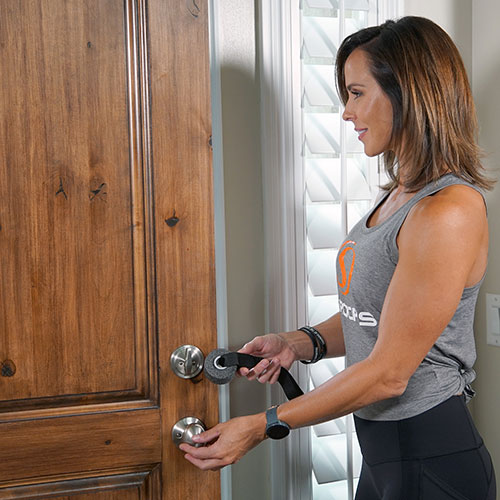High-Intensity Interval Training (HIIT) is a time-efficient workout method that combines short bursts of intense exercise with brief recovery periods. Essentially, it’s like an extreme cardio workout that helps you build muscle and endurance as well. When coupled with resistance bands, HIIT becomes even more challenging and effective.
Getting started in HIIT, it’s best to have some guidance on how to do it right. You want to, of course, make sure that your workout is actually challenging you. Likewise, you need to know your limits and define your workout based on what you actually can accomplish. For example, you may not think 8-10 minutes of exercise is very much, but if you underestimate the amount of rest time you need between burst periods, you may find yourself struggling to finish even that much.
Here’s a detailed guide on designing a resistance band HIIT workout and some sample exercises that could help get you started on having the right idea for your HIIT routine. By incorporating these exercises into your routine, you can enhance muscular strength, boost cardiovascular fitness, and achieve remarkable results in less time.
Designing a Resistance Band HIIT Workout
Every workout requires attention to detail to be truly effective, but the same is even more true for HIIT exercise. Designing a resistance band HIIT workout requires careful planning to ensure maximum effectiveness. Follow these steps to create a well-rounded routine:
1. Warm-up
Begin with a dynamic warm-up to prepare your body for the intense workout ahead. Incorporate exercises such as jumping jacks, arm circles, and bodyweight squats to increase blood flow, raise your core temperature, and activate major muscle groups.
2. Exercise Selection
Even in a short amount of time, HIIT exercise gives you ample opportunities to change it up. Make sure to choose a variety of exercises that target different muscle groups.

It’s best if you aim for compound movements that engage multiple muscles simultaneously, such as squats, lunges, rows, presses, and core exercises. These exercises will maximize calorie burn and promote overall strength development.
3. Work-Rest Ratio
This is a big one. Remember the example from before? Underestimating your needed rest time can cause your workout to be more strenuous than necessary and arguably less effective.
Determine your desired work-to-rest ratio based on your fitness level and goals. A common ratio is 1:2, where you perform a high-intensity exercise for a set time or number of repetitions, followed by an equal rest period. For example, you may do 30 seconds of intense resistance band squats, followed by a minute of rest. Adjust the ratio as needed to challenge yourself while maintaining proper form.
Serious athletes at higher levels may opt for a smaller ratio like 1:1, but make sure to work up to that level if you’re not already there. Trying to start at a higher point with the expectation that your body will adjust to it or improve will not lead you to results.

4. Intensity Levels
Adjust the resistance level of your bands to match your fitness level and exercise requirements. Start with lighter bands and gradually progress to heavier resistance as you become stronger and more comfortable with the movements. Remember to prioritize good form and control over the band’s tension.
5. Circuit Structure
Organize your exercises into circuits, performing each exercise back-to-back with minimal rest between them. Aim for 2-4 circuits depending on your time availability and fitness level. Ensure that each circuit targets different muscle groups for a balanced workout.
6. Cool-down
When getting started with HIIT, you might not want to do much more than collapse on the ground or a bench and wait for your breath to come back. Make sure to conclude your resistance band HIIT workout with a proper cool-down to facilitate recovery and reduce muscle soreness. Incorporate static stretching exercises to improve flexibility and promote relaxation.
Sample Resistance Band HIIT Workout
Here’s a sample resistance band HIIT workout to get you started:
Circuit 1
1. Resistance Band Squats: 45 seconds
– Stand on the resistance band with feet shoulder-width apart, holding the handles at shoulder level. Squat down, keeping your chest up and knees tracking over your toes.
2. Resistance Band Rows: 45 seconds
– Secure the band around a sturdy anchor point. Hold the handles with arms extended and palms facing inward. Pull the bands towards your chest, squeezing your shoulder blades together.
3. Resistance Band Mountain Climbers: 45 seconds

– Place the band around your ankles. Get into a high plank position, hands directly under your shoulders. Alternate bringing your knees towards your chest while maintaining a strong core.
Rest for at least 60 seconds between circuits.

Circuit 2
1. Resistance Band Push-ups: 45 seconds
– Wrap the band around your back, holding the handles with hands on the ground in push-up position. Perform push-ups, keeping your body in a straight line.
2. Resistance Band Lateral Lunges: 45 seconds
– Stand on the band with feet hip-width apart. Hold the handles at shoulder level. Step to the side with one leg, bending the knee and pushing your hips back. Return to the starting position and alternate sides.
3. Resistance Band Plank Jacks: 45 seconds
– Place the band around your ankles and get into a high plank position. Jump your feet out wide, then back together while maintaining a strong core.
Rest for at least 60 seconds between circuits.
Repeat the circuits 2-4 times based on your fitness level.
Wrap It Up
Incorporating resistance bands into your HIIT training amplifies the benefits and challenges of this efficient workout method. By designing a resistance band HIIT workout that incorporates compound exercises, appropriate work-to-rest ratios, and progressive intensity, you can achieve significant improvements in muscular strength, cardiovascular fitness, and overall performance.
Start incorporating these sample exercises into your routine and experience the exciting results of resistance band HIIT training.
Follow our blog for more tips and guidance on your fitness journey.

0 Comments